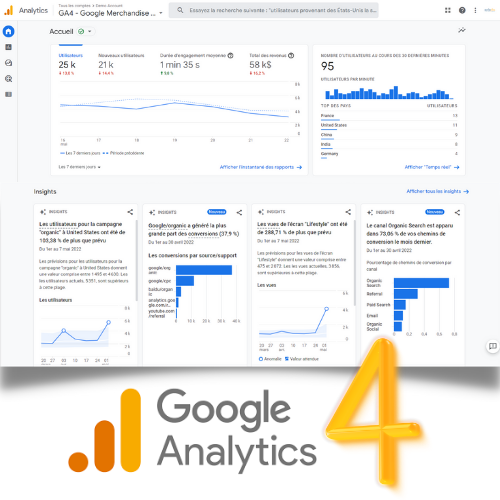Google has announced the end of Universal Analytics (GA3) on July 1, 2023. A real revolution when you consider that 10 million sites, or more than 80% of the global market, use Google Analytics* for their tracking. Switching your tracking events to Google Analytics 4 is therefore both essential and urgent! The webmarketing experts at Soledis provide you with the keys to understanding this change, and how to make the most of it. adaptation solutions.
1- Why Google Analytics 4?
GA4 is Google's new tracking tool, destined to completely replace Universal Analytics from July 1, 2023. To explain this transformation, Google points to respect for data confidentiality and advances in artificial intelligence with machine learning.
First and foremost, GA4 has gained in accessibility: the interface is simpler and more ergonomic, making it a tool accessible to all. This was not the case with Universal Analytics, which was rather complex to learn.
What's more, GA4 is more precise than its predecessor: in addition to cross-device tracking (mobile, desktop, tablet) already possible in Google Universal Analytics, Google Analytics 4 (GA4) enables cross-platform tracking (website, mobile app). It uses three levels of identification: device_id, Google Signals, user_id. GA4 enables the same user to be tracked across multiple devices, regardless of the platform used.
The last reason is more political: GA4 gives you access to new features to control your data collection namely automatic IP address anonymization, data deletion on request or even data collection by google signals. This is Google's last-ditch attempt to comply with RGPD requirements and avoid formal notices from the CNIL (more).
2- The 5 main differences between Universal Analytics and Google Analytics 4?
As some of you may have noticed, GA4 is not a simple evolution but a real paradigm shift.
a) A different philosophy
Whereas Universal Analytics was based on tracking sessions and page views, GA4 focuses on users and events. A page view is now an event. Each event can be completed with customized parameters.
GA4 is also a more intuitive tool, offering a lighter interface than its predecessor. There are fewer reports, but more widgets for customizing reports (in line with the parameters added to your events).
b) More tracked data, less tagging
On GA4, more events are tagged by default and without any tagging action from you (or your webmarketing agency). Where Universal Analytics only tracked page views (natively), GA4 also tracks scrolls, internal site search, outbound clicks, engagements on videos embedded in your website and file downloads. In GA4's "Enhanced Metrics" menu, all you have to do is activate these metrics.
c) Follow-up on web and app as well as PC and phone
Whether the user switches from Chrome on his desktop PC to the app on his Android phone, via the Safari browser on his Apple tablet, there is less impact on the tracking of his movements. GA4 can recognize and track the same user across multiple devices and sources (web, iOs, Android apps).
d) Greater respect for private life**.
IP addresses are automatically anonymized (no need to do it by hand anymore), data collection settings are more refined, ads can be configured by zone, by event type, by user type, and all data can be deleted on request: these are the most important changes in terms of privacy.
e) Use of artificial intelligence
Thanks to the use of AI, GA4 constantly suggests "Insights": in the search field as soon as you type even a single word, in reports, in an annotation panel to be discovered thanks to the "Insight" button at the top right of your screen...
Google is also using AI to make GA4 work without cookies. This is machine learning based on probabilism, which fills in the data previously collected by cookies.
To explore Google Analytics 4, consult Google documentation or access their demo account.
3- Don't neglect your GA4 adaptation time
There's no need to resist: Google has already automatically created your GA4 account if you had Universal Analytics (GA3), and your Universal Analytics (GA3) data will only be accessible until December 2023.
The data accumulated in Universal Analytics is not compatible with GA4 and cannot be migrated from one to the other. They will simply remain available for consultation and export until December 31, 2023, when they will be destroyed by Google.
GA4's tracking philosophy is completely new, and bears no resemblance to Universal Analytics. Even when the same data is tracked, it changes name in GA4 (thanks Google). It will take you some time to learn to speak the same language as this new tracking tool and exploit it to its full potential.
What's more, some features don't yet exist in GA4: intelligent lenses, custom dimensions in standard reports, advanced filters for exclusions, the URL page as the default dimension, the limited predefined report... Some of these may soon make their appearance in GA4, but for the others, you'll have to get used to living without them. In this respect, GA4 is a real change in tracking philosophy that will test your ability to adapt.
4- How can Soledis help you?
Soledis can support you in this transition with :
- GA4 installation and configuration
- Google Tag Manager verification and configuration
- Installation and configuration of a Prestashop module selected and tested by us to upload your e-commerce data
- Migration acceptance testing, i.e. verification of data feedback and tracking plan.
We can also adapt our offer to your situation: installation of Google Tag Manager if you do not yet use this tool, redesign or creation of your tracking plancreation of Looker Studio dashboard to go further in analyzing your data...
